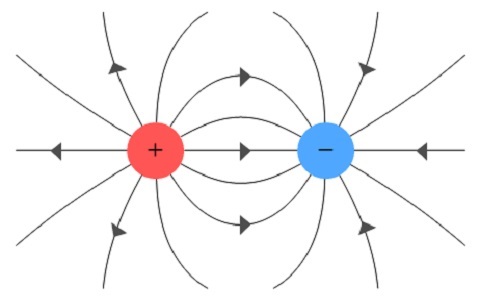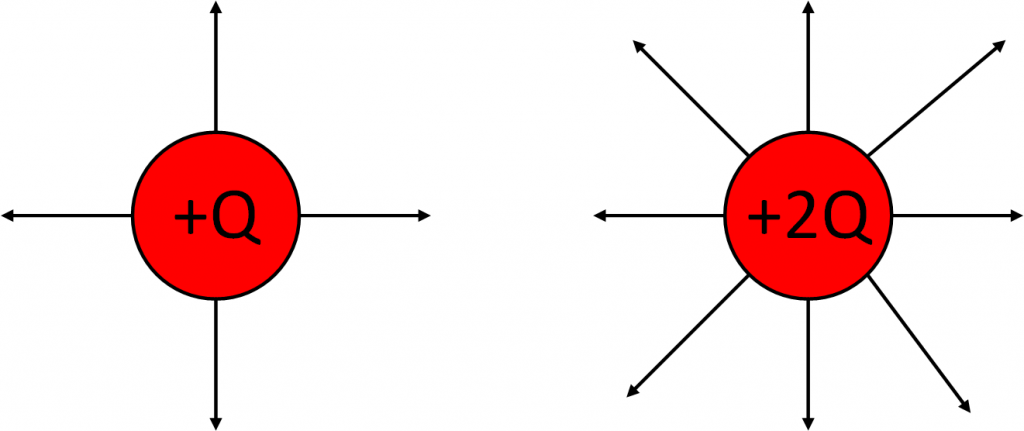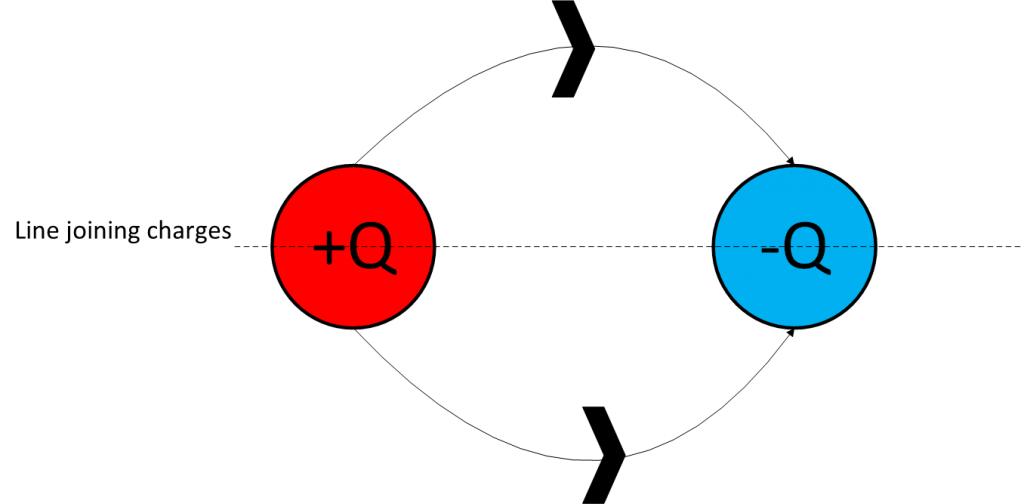Electric Field Lines : Properties, Diagram and Rules to Draw
Electric field lines may be considered as a visual representation of the electric field existing between or for a charge itself. It was introduced by Michael Faraday in the year (1791-1867) who named them lines of force. A field basically is a function that specifies a particular quantity everywhere in a region. When we say electric field lines, it gives us means of representing the electric field pictorially. By looking into the electric field lines, its magnitude, orientation, and other properties can be evaluated. As shown in the below figure electric field lines exist between positive and negative charges. The lines of forces are directed outwards for positive charge and inwards for a negative charge. The arrow represents the direction of the force. The magnitude can also be considered based on a number of arrows and density around the charge. In other words, a number of lines or arrows is proportional to the magnitude of the electric field in a particular region. As shown above, the electric field is vector E is tangent to an electric field line at each point. The line has the same direction as the direction of the electric field.
The number of lines of force leaving the positive charge is equal to a number of lines terminating on a negative charge. If the charge is equal and opposite, the same number of lines leave and terminate at respective charges. In the case of a single charge present, the lines of force radiate outwards in case of positive charge and tend to infinity.
Mục Lục
What is Electric Field Lines?
The electric field may be defined as “Electric field lines are imaginary lines in a region of space-time along which a free charge would move if allowed to do so”. This means that electric field lines or lines of force are a visual representation of the electric field in a region, which exists between two charges. Just like a magnetic field that exists between two poles. The force existing between two charges is directly proportional to the product of charges and inversely proportional to the square of the distance between them as per Coulomb’s Force Law.

Properties of Electric Field Lines
Some important properties of electric field lines are given below:
The electric field lines or lines of force originate from the positive charge and terminate at a negative charge. Same as magnetic lines of force which orient from the north pole to south pole
The lines of force that exist between two charges never form any closed path. Which means that the lines originating from positive charge terminate at a negative charge, and do not come back to the positive charge.

As shown in the above figure, the lines of force originate from positive charge but do not come back and hence do not form any closed loop. It may be noticed that the magnetic lines of force form a closed path i.e. starting from north pole move towards the south pole and come back to the north pole.
The lines of force that originate from positive charge, in case of absence of negative charge i.e. single charge case, never terminate in space. They tend to exist up to infinity. Magnitude decreases as the distance are increases, but they never terminate at the origin.
The lines of force originating or terminating at a charge is subjective, but whereas the density of lines of force is objective. This means that a number of lines originating from a charge may vary for different charges, but the density of these lines around the charge must be uniformly decreasing as they move away.
The lines of force originating for terminating at charge are directly proportional to the magnitude of charge.

As shown in the above figure, if a number of lines originating from +Q are 4, then the number of lines originating from +2Q would be 8.
The lines of force originating or terminating at a particular charge are symmetrical to the line joining two charges.

As shown in the figure, the lines of force are symmetrical over line joining charges. This means that the same number of lines exist above and below the line joining charges.
The density of lines originating or terminating for the respective charge gives the magnitude of the charge.
The lines of force are perpendicular to the surface of the charge.
The direction of this is given by the tangent drawn at lines of force. The direction of the tangent gives the direction of the electric field.
The lines of force originating or terminating at a particular charge, never intersect each other. If we draw a tangent at the point of intersection, then it will give two directions at the same point. Hence, the lines of force never intersect with each other.
If field lines are originating from positive charge, then in presence of one more positive charge, the field line will repel. That means field lines repel to positive charge and similarly attract towards negative charge.
A uniform electric field is represented by parallel, straight and equally spaced lines of force.
If a conductor is under electrostatic condition then there would be no electric field existing in the conductor. If these lines exist, then it would impose a force on the electrons, which will move the electrons and hence produce current. Then the electrostatic condition is not valid. Hence it is said that, under electrostatic conditions, the electric field existing is zero.
These are always perpendicular to the surface of the conductor.
Electric Field lines Attraction and Repulsion
The electric field lines get attracted to the negative charge and there exists a repulsion for the positive charge. If there are two positive charges nearby, then the line of force originating from the positive charges would repel and bend towards infinity. They never intersect with each other.
Rules for Drawing
To draw electric field lines, the following rules need to be followed.
- These lines originate from positive charge and terminate at a negative charge.
- The field lines originating are always perpendicular to the surface of the charge.
- Two field lines never intersect each other.
- The field lines are attracted to negative charges and repel from the positive charge.
- These are symmetrical about the line of joining the charges.
- These are proportional to the magnitude of charge.
FAQs
1). Do electric field lines ever end?
No, if there is a single positive charge, then field lines originate from it and tend towards the infinity. They never end. However, if we have positive and negative charges, then lines of force terminate at a negative charge.
2). Where are the electric field lines strongest?
The field lines are strongest near the charge and become weak as they move away from the charge.
3). What are the three properties of electric field lines?
The three properties are:
- The field lines originate from positive charge and terminate at a negative charge
- The field lines are perpendicular at the surface of the charge
- The field lines never intersect with each other.
4). How is the electric field defined?
The electric field is a particular function that specifies lines of force everywhere in a region
5). What is the SI unit of electric field?
The SI unit of electric field strength is newtons per coulomb (N/C) or volts per meter (V/m)
Hence we have seen how the electric field is defined and we have seen the properties of the electric field. This helps to understand the characteristics of electric field strength based on which we can evaluate electric field strength and electric field density. These characteristics and properties of the electric field help us to understand Gauss Law and Maxwell Rules. We have also seen the rules to draw the electric field and some frequently asked questions. Here is a question for you, how do electric field lines are different from magnetic field lines?















![Toni Kroos là ai? [ sự thật về tiểu sử đầy đủ Toni Kroos ]](https://evbn.org/wp-content/uploads/New-Project-6635-1671934592.jpg)


